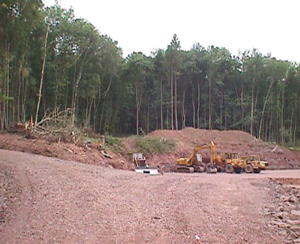|
|
Whitehouse Estate is set in the Golden Valley and comprises managed
forest and pastureland which offer limited recreation
saftey first
Everyone using or visiting the Estate should consider their own safety as well as that of others. The Estate maintains insurance policies and we are anxious to minimise the cost of premiums by maintaining a safe environment with a no claims history.

The woods comprise 71.5 hectares which is mostly hardwood but which includes some conifer. Part is ancient semi-natural woodland, which affects management. Tree age is diverse.
 Commercial Forestry has been practised on the Estate for generations as the attached article shows. Commercial Forestry has been practised on the Estate for generations as the attached article shows.
There are 3.5 km of new and improved roads , which means lorry access from public roads to loading areas is excellent and machinery can easily be used within the woods without causing much damage to soil or watercourses. These roads should be kept well drained, as dry as possible and in good repair to prolong their useful life.
 |
Economics dictates that the entire woodland area will be thinned on cycle of at least 6 years but then over say 2 years using specialist contractors so promoting local employment.
Most of the woods were thinned in 2005-2008 and they are unlikely to be thinned again until at least 2014. Tree thinning has and will continue to favour hardwoods, especially oak, but some conifers will be retained to enhance contrast and shelter. We aim to encourage the structural diversity of the woods by:
- Not clear felling ie not cutting-down all trees on an area of more than 0.25 ha thus needing expensive replanting, weeding, risking soil erosion, disrupting the landscape and wildlife.
- Practising continuous cover ie maintaining the forest canopy without clear felling. We aim to manipulate the canopy by removing single or small groups of trees, thus controlling the light regime under the canopy and encouraging younger trees to develop and natural regeneration, but not detrimental weed growth. Natural regeneration may be supplemented by some tree planting. Some chemical and or mechanical weeding may be necessary. An uneven aged woodland, with different ages of trees co-existing within the forest stand develop. This should help the next tree generations to establish themselves before the oldest trees are harvested. Oak needs much light for natural regeneration to be successful.
- Encouraging the under storey including hazel.
- Retaining standing and fallen deadwood unless unsafe to public using authorised footpaths.
- Retaining and safeguarding all veteran trees.
- Safeguarding species diversity esp wild service tree, wych elm, lime, field maple etc.
- Mowing 3500 m of rides to an overall irregular width of 5m-9m with additional scallops of 20m x 5m @ 100 m c/c approx but retaining pinch points to act as dormouse corridors every 50m approx.
- Mowing / swiping 3 x 20m diameter glades.
- Safeguarding the Blackpool Pond, watercourses and springs by maintaining 50% dappled shade.
- Avoiding damage to soil, wood banks and the wet woodlands identified as W6 and W7 on plan attached to the 1978 ecological survey report.
- Excluding stock from the woodland.
- Controlling Grey squirrels, which have previously caused much damage, and other vermin.
Selected trees may be pruned.
This management style should enhance wildlife diversity. Prior to 2005 the woods were dark and unwelcoming to wildlife.
Woodland thinning aims to encourage a final crop worth considerably more than that which would be achieved without thinning. It is important to achieve a valuable final crop to fund work which could not otherwise be afforded. Please see our timber for sale page.

The 91 acres of pastureland are let. A traditional barn and pole hay barn are included.
Hedgerows and copses provide shelter for stock and wildlife and add to the landscape. New hedgerows have been planted within new fences.
The pastureland has also benefited from the improved access that the forest roads afford.

Surveys were undertaken in 1998 and are attached. We are encouraging further study by forming relationships with wildlife groups and the local school.
 Field Field
 Wood Wood
|





